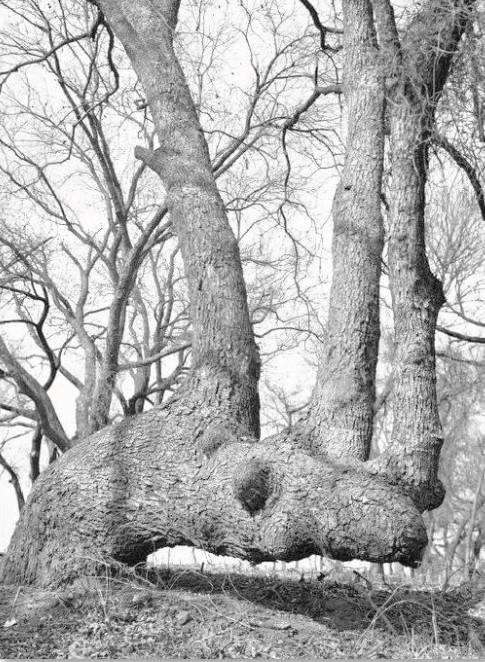Making Its Mark: Comanche Nation to Recognize Indian Marker Tree

After six years of research, plans are to officially dedicate this severely bent tree in July as a Comanche Nation Marker Tree.

Published June 19, 2017, By Lana Sweeten-Shults
Dr. Seuss wrote in his children’s story, “The Lorax”: “I am the Lorax. I speak for the trees. I speak for the trees, for the trees have no tongues.” If only trees did have tongues, what tales they might tell.
They might tell you of brave Comanches, point to a water source, or mark the way to a grave, low water crossing or a hunting site. One severely bent tree in Holliday, Texas, might tell you those tales and more. The tree, at Stonewall Jackson Camp No. 249, about 85 yards south of the United Confederate Veterans monument, near a stream behind the baseball field, is no mere tree.
After six years of research, plans are to officially dedicate it sometime in July as a Comanche Nation marker tree — a rare find, as it is one of only nine documented in Texas and recognized by the Comanche Nation.
I am 80 years old and I’m just now finding out about them,” Comanche elder Robert Atchavit of Wichita Falls said about Indian marker trees. Not many have heard of them.
American Indians would take a sapling and tie it down so it would grow in an unusual way. Typically, part of the tree grows horizontal to the ground and, oftentimes, branches grow vertically from that bent area. Most people would think the tree was just deformed by some force of nature and wouldn’t think much else of it, unless that person happens to be familiar with Indian marker trees.
Retired school principal Don Briix happened to be one of those people. He was riding his bike in December 2010 when he noticed a 60-foot-tall, knobby pecan tree with a 12foot base that seemed to have grown parallel to the ground. Briix, who has since moved away from Holliday, happened to have learned about marker trees from a park ranger who had pointed one out when he was in Florissant, Colorado.
The Holliday marker tree, with three branches growing vertically out of that horizontal base, looked like the one he had seen in Colorado. And so began the process to find out whether the tree really is a Comanche marker tree. “They (members of the Texas Historic Tree Coalition) came and climbed the tree and took samplings. … They said, yes, it was a Comanche marker tree,” Atchavit said.
Arborist Steve Houser, director of the coalition’s Indian Marker Tree Project, has researched these marker trees for more than two decades and thought back in 2011 that the Holliday tree might be a marker tree. Houser told Times Record News reporter Ken Fibbe that to identify the Holliday tree as an Indian tree marker, he needed a “tree cookie,” or a cross section slice of a dead limb, which would tell him how fast or slow the tree was growing. Fibbe provided Houser with that tree cookie.
Researchers such as Houser keep their eye out for various marker tree indicators, such as the tree’s age. It must be at least as old as the last known existence of the tribe in the area. For the Comanches in Texas, that means at least 150 to 175 years old. The tree also must have been indigenous to the area at the time, so a red cedar, pecan, oak or walnut tree.
They also look for long scars, or deep scar lines along the base of the tree, where it grew around the material used to tie it down. Indian marker trees generally are more severely bent than they might be if natural causes were the culprit.
Experts also research the Indians who lived in the area and if they were known to use marker trees. If Indian arrowheads, stone tools and the like exist nearby, then that’s an indication, too, that a particular tree might be a marker tree.
“It took a lot of research, a lot of background history on the site,” Houser said of the Holliday Comanche Nation marker tree, which would be the ninth recognized by the Texas Historic Tree Coalition, a group dedicated to researching, recognizing and celebrating historic trees in Texas.
The 2016 book “Comanche Marker Trees of Texas,” written by Houser, anthropologist Linda Pelon, and Comanche tribal officer Jimmy Arterberry, documents six Indian marker trees.
“Three others (have been recognized) since the book was published,” Houser said, “with one of them being the Holliday tree. … Maybe we’ll write another book in the future. It just takes so much time to research one of these trees.”
The first Indian marker tree to be officially recognized by the Comanche Nation’s Tribal Elder Council, Historic Preservation Officer and Language and Cultural Preservation Committee was at the White Rock Creek trail at Gateway Park in East Dallas in 1997. That tree blew over in a storm just a year later.
And so the process continues to recognize these trees, living history that may not be around much longer. Houser said about 100 trees are now being researched, “So hopefully there will be more in the future.”
Many Native Americans, like Atchavit, never have heard of Indian marker trees, since much of their history was lost when American Indians were moved to reservations and forced to abandon their culture. Recognizing these marker trees is one way to reclaim that history.
Atchavit, who took care of the tree with Briix before he moved away, said it’s been a long time coming to get the Holliday tree recognized as an Indian marker tree. “We got it authenticated and we’re so happy about it,” he said.
"I do this as a volunteer," Houser said of his work researching these Indian marker trees. "It's something I enjoy doing, reconnecting Comanches to a significant part of their history."
